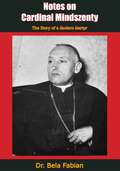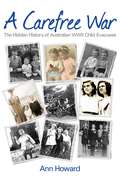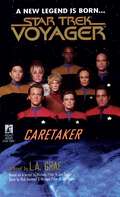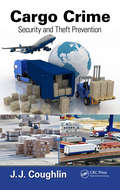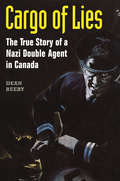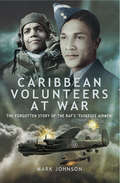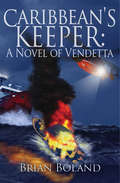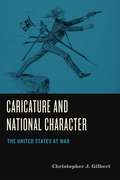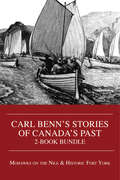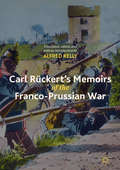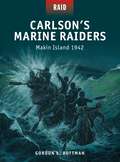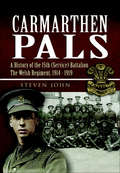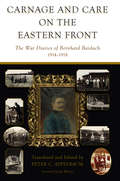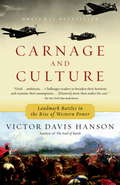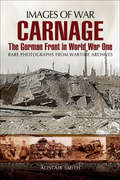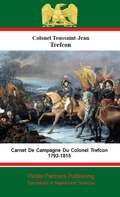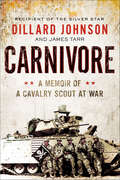- Table View
- List View
Cardinal Mindszenty: The Story of a Modern Martyr
by Dr Bela Fabian“Readable, stirring, and significant”—George N. Shuster, Saturday Review“To read this human story of a strong but simple man—Cardinal Mindszenty—is to be inspired to love better your God, your country and your fellowman, for it is a stirring story of faith and charity, of tolerance, loyalty and friendship.”—Francis Cardinal Spellman, Archbishop of New YorkJózsef Cardinal Mindszenty (1892-1975) was the Prince Primate, Archbishop of Esztergom, cardinal, and leader of the Catholic Church in Hungary (1945-1973) who was imprisoned by the pro-Nazi Arrow Cross Party during World War II and after the war, being a strong opponent of communism and the communist persecution in his country, was tortured and given a life sentence in a 1949 show trial that generated worldwide condemnation.Rather than a carefully written account of Cardinal Mindszenty’s career, here is an account of what the Cardinal heard and saw during the events which led up to the most sensational trial in Hungarian history…
Carefree War: The Hidden History of Australian WWII Child Evacuees
by Ann HowardDuring World War II Australia was under threat of invasion. Could Australia be invaded by the Japanese? Even with the heavy censorship by the government many certainly thought so. Stunned families had followed the bombings and atrocities of war that were taking place in Europe, and the nation was gripped by fear that the danger would soon be on their doorstep. The Japanese appeared to be looming closer; there were submarines in Sydney Harbour, Japanese planes flying overhead and harassment on our coastline. Australians were fearful for their safety. Anxious parents made decisions to protect their children, with or without government sanction. Small children, some just out of babyhood, were sent away, often unaccompanied, by concerned parents to friends, relatives, or even strangers living in ‘safer’ parts of the country. Many had little comprehension of what was happening and thought they were going on a holiday to the country. The history of these child evacuees in Australia remains largely hidden and their experiences untold. Author Ann Howard, who was evacuated with her mother from the UK during World War II, is setting the records straight. A combination of extensive research and the first-hand stories of the evacuees captures the mood of the time and the social and political environment that they lived in.
Caretaker (Star Trek)
by L.A. GrafA Simon & Schuster eBook. Simon & Schuster has a great book for every reader.
Cargo Crime: Security and Theft Prevention
by John J. CoughlinCargo crime including theft, fraud, and the passage of contraband through commercial shipping lanes poses an enormous threat to security and the economy. By understanding the current methods and operations of those who attack the supply chain, industry professionals can design effective security plans and law enforcement can properly investigate th
Cargo of Lies: The True Story of a Nazi Double Agent in Canada
by Dean BeebyOn a chilly autumn night in 1942, a German spy was rowed ashore from a U-boat off the GaspT coast to begin a deadly espionage mission against the Allies. Thanks to an alert hotel-keeper's son, Abwehr agent `Bobbi' was captured and forced by the RCMP to become Canada's first double-agent. For nearly fifty years the full story of the spy case, code-named Watchdog, was suppressed. Now, author Dean Beeby has uncovered nearly five thousand pages of formerly classified government documents, obtained through the Access to Information Act from the RCMP, the Canadian Security Intelligence Service, the Department of Justice, the National Archives of Canada, and Naval Intelligence. He has supplemented this treasure trove with research among still heavily censored FBI files, and interviews with surviving participants in the Watchdog story. Although British records of the case remain closed, Beeby also interviewed the MI5 case officer for Watchdog, the late Cyril Mills. The operation was Canada's first major foray into international espionage, predating the Gouzenko defection by three years. Watchdog, as Beeby reveals, was not the Allied success the RCMP has long claimed. Agent `Bobbi' gradually ensnared his captors with a finely spun web of lies, transforming himself into a triple-agent who fed useful information back to Hamburg. Beeby argues that Canadian authorities were woefully unprepared for the subtleties of wartime counter-espionage, and that their mishandling of the case had long-term consequences that affected relations with their intelligence partners throughout the Cold War.
Caribbean Volunteers at War: The Forgotten Story of the RAF's 'Tuskegee Airmen'
by Mark Johnson&“During the Second World War nearly 500 Black Caribbean volunteers served with the RAF . . . This valuable work looks at their experiences.&”—HistoryOfWar The heroic exploits of the Caribbean men and women who volunteered their services to the Allied effort during the Second World War have, until now, passed by with little fanfare or attention. Indeed, whilst many people are aware of the contribution that the various Bomber Command units paid in securing ultimate victory, little is said or understood of the achievements and sacrifices of the heroic Caribbean volunteers who contributed to some of their greatest victories. Mark Johnson presents us here with an engrossing and humane account of the exploits of such individuals—including a great number of insights and fascinating details taken from conversations with his great-uncle, John Blair, who served a full tour with Bomber Command, earning a Distinguished Flying Cross. The book illuminates the day-to-day reality of life as a Caribbean volunteer during the Second World War and the kind of culture-clash experiences that characterized their wartime careers. An important book, offering a platform upon which to appreciate the true extent of the Caribbean contribution to the Allied war effort, the work offers a new slant on the popular Bomber Command theme; one that looks set to intrigue a number of readers yet to be acquainted with this facet of the unit&’s history. &“Entertaining and rewarding . . . it is high time we had more books like this one plugging the knowledge gap and setting a few things straight.&”—War History Online
Caribbean's Keeper: A Novel of Vendetta
by Brian BolandThis debut thriller by a US Coast Guard aviator will take you onto a cutter fighting drug runners at sea--and into the terrifying world of modern-day pirates. Lt. Junior Grade Cole Williams has always been at home on the sea, racing sailboats and crewing yachts during his time as a cadet at the United States Coast Guard Academy. But when he reports aboard a cutter patrolling the Caribbean, he can't seem to please the command, and his attempts to do the right thing always seem to land him in hot water. At the end of a cruise on which he serves admirably during open-ocean rescues and in hot pursuit of drug runners, Cole is unceremoniously kicked out of the Coast Guard for what the command deems reckless behavior and a bad attitude. Dejected and disillusioned, he decides to go rogue--and make a few unsanctioned runs for the smugglers he's already spent so much time chasing. Navigating devious and dangerous twists and turns, Cole shifts from modern-day pirate to criminal fugitive. Ultimately, he'll be forced to choose between staying on the wrong side of the law or taking a deadly risk for the Joint Task Force charged with stemming the flow of illegal narcotics. While seldom in the headlines, the southern border of the United States has been a battleground for years, and the men and women of the US Coast Guard have fought tirelessly to keep lethal substances off the nation's streets. In his debut novel, author Brian Boland shares a story born from more than a decade of experience fighting the war on drugs.
Caribbee: Thomas Kydd 14
by Julian Stockwin'In Stockwin's hands the sea story will continue to entrance readers across the world' - GuardianMore than a decade ago, Thomas Kydd and Nicholas Renzi were in the Caribbean as sailors before the mast in the old Trajan. Now Kydd, a storied hero of Trafalgar, holds the glory of being post-captain of the 32-gun frigate, L'Aurore. After unremitting war a Caribbean posting seems a welcome respite. But Kydd and Renzi soon find themselves facing a familiar threat as the French imperil Britain's vital sugar trade.When merchantmen begin vanishing from the sea, Kydd and Renzi must embark on a dangerous game of espionage, seamanship and breath-taking action in order to destroy a new and terrible danger to the Empire.*********************What readers are saying about CARIBBEE'A proper swashbuckling affair' - 5 stars'Totally amazing!' - 5 stars'Loved this book' - 5 stars'A real find' - 5 stars'A gripping read' - 5 stars
Caribbee: Thomas Kydd 14 (Kydd Sea Adventures Ser.)
by Julian Stockwin'In Stockwin's hands the sea story will continue to entrance readers across the world' - GuardianMore than a decade ago, Thomas Kydd and Nicholas Renzi were in the Caribbean as sailors before the mast in the old Trajan. Now Kydd, a storied hero of Trafalgar, holds the glory of being post-captain of the 32-gun frigate, L'Aurore. After unremitting war a Caribbean posting seems a welcome respite. But Kydd and Renzi soon find themselves facing a familiar threat as the French imperil Britain's vital sugar trade.When merchantmen begin vanishing from the sea, Kydd and Renzi must embark on a dangerous game of espionage, seamanship and breath-taking action in order to destroy a new and terrible danger to the Empire.*********************What readers are saying about CARIBBEE'A proper swashbuckling affair' - 5 stars'Totally amazing!' - 5 stars'Loved this book' - 5 stars'A real find' - 5 stars'A gripping read' - 5 stars
Caricature and National Character: The United States at War (Humor in America #1)
by Christopher J. GilbertAccording to the popular maxim, a nation at war reveals its true character. In this incisive work, Chris Gilbert examines the long history of US war politics through the lens of political cartoons to provide new, unique insights into American cultural identity.Tracing the comic representation of American values from the First World War to the War on Terror, Gilbert explores the power of humor in caricature to expose both the folly in jingoistic virtues and the sometimes-strange fortune in nationalistic vices. He examines the artwork of four exemplary American cartoonists—James Montgomery Flagg, Dr. Seuss, Ollie Harrington, and Ann Telnaes—to craft a trenchant image of Americanism. These examinations animate the rhetorical, and indeed comic, force of icons like Uncle Sam, national symbols like the American Eagle, political stooges like President Donald J. Trump, and more, as well as the power of political cartoons to comment on issues of race, class, and gender on the home front. Throughout, Gilbert portrays a US culture rooted in and riven by ideas of manifest destiny, patriotism, and democracy for all, yet plagued by ugly forms of nationalism, misogyny, racism, and violence.Rich with examples of hilarious and masterfully drawn caricatures from a diverse range of creators, this unflinching look at the evolution of our conflicted national character illustrates how American cartoonists use farce, mockery, and wit to put national character in the comic looking glass.
Caricature and National Character: The United States at War (Humor in America)
by Christopher J. GilbertAccording to the popular maxim, a nation at war reveals its true character. In this incisive work, Chris Gilbert examines the long history of US war politics through the lens of political cartoons to provide new, unique insights into American cultural identity.Tracing the comic representation of American values from the First World War to the War on Terror, Gilbert explores the power of humor in caricature to expose both the folly in jingoistic virtues and the sometimes-strange fortune in nationalistic vices. He examines the artwork of four exemplary American cartoonists—James Montgomery Flagg, Dr. Seuss, Ollie Harrington, and Ann Telnaes—to craft a trenchant image of Americanism. These examinations animate the rhetorical, and indeed comic, force of icons like Uncle Sam, national symbols like the American Eagle, political stooges like President Donald J. Trump, and more, as well as the power of political cartoons to comment on issues of race, class, and gender on the home front. Throughout, Gilbert portrays a US culture rooted in and riven by ideas of manifest destiny, patriotism, and democracy for all, yet plagued by ugly forms of nationalism, misogyny, racism, and violence.Rich with examples of hilarious and masterfully drawn caricatures from a diverse range of creators, this unflinching look at the evolution of our conflicted national character illustrates how American cartoonists use farce, mockery, and wit to put national character in the comic looking glass.
Carl Benn's Stories of Canada's Past 2-Book Bundle: Mohawks on the Nile / Historic Fort York
by Carl BennMilitary historian Carl Benn explores the rich history of our nation with two absorbing stories of bravery in this special two-book bundle. Mohawks on the Nile: Natives Among the Canadian Voyageurs in Egypt, 1884-1885 Mohawks on the Nile explores the absorbing history of sixty Aboriginal men who left their occupations in the Ottawa River timber industry to participate in a military expedition on the Nile River in 1884-1885. Chosen becuase of their outstanding skills as boatmen and river pilots, they formed part of the Canadian Voyageur Contingent, which transported British troops on a fleet of whaleboats through the Nile’s treacherous cataracts in the hard campaigning of the Sudan War. Historic Fort York, 1793-1993 Fearing an American invasion of Upper Canada, John Graves Simcoe had Fort York built in 1793 as an emergency defensive measure. That act became the first step in the founding of modern Toronto. In this book, Carl Benn explores the dramatic roles Fort York played in the frontier war of the 1790s, the birth of Toronto, the War of 1812, the Rebellion of 1837 and the defence of Canada during the American Civil War, and describes how Toronto’s most important heritage site came to be preserved as a tangible link to Canada’s turbulent military past.
Carl Rückert's Memoirs of the Franco-Prussian War
by Alfred KellyThis book offers the first English-language translation of the finest soldier’s memoir to emerge from the Franco-Prussian War, titled With my Rucksack: The Unvarnished Campaign Memoirs of an Infantryman from the Year 1870 by Carl Rückert. Lasting from 1870–1871, this was the war that made the modern German nation and set Europe on the path to World War I, and Carl Rückert offers an unrivalled worm’s eye view of the experiences of common soldiers who fought in it. A Hessian lance corporal in the German army, he was a close observer of daily hardships, class tensions, the influence of nationalism, and the terrors of combat. He was gravely wounded in the war’s decisive battle at Gravelotte, where he was among the first Europeans to face the horrors of breech-loading rifles, machine guns, and accurate artillery. Accompanied by an insightful translator’s introduction and a wealth of footnotes, this book is an invaluable link to the everyday realities of the Franco-Prussian War.
Carlisle Barracks (Images of America)
by Roger S. DurhamCarlisle Barracks was established by the British Army in 1757 to support operations against the French during the French and Indian War. During the Revolutionary War, the post supported Washington's army against the British. After the post was burned by Confederate forces during the Civil War, it was rebuilt and served as the U.S. Army's Cavalry School until 1871, when the post was closed. In 1879, the Carlisle Indian Industrial School opened at the post to educate Native American children. This school operated until 1918, when the U.S. Army resumed control of the post and opened a hospital to care for wounded World War I soldiers. The U.S. Army Field Medical School opened there in 1920 and remained until that function was relocated in 1946. In 1951, the U.S. Army War College moved to Carlisle Barracks, where it remains. Using vintage photographs, Carlisle Barracks chronicles how for more than 250 years this post has supported military operations and training and continues to do so today.
Carlisle in the Great War (Your Towns & Cities in the Great War)
by David M CarterHow the experience of war impacted on the town, from the initial enthusiasm for sorting out the German kaiser in time for Christmas 1914, to the gradual realization of the enormity of human sacrifice the families of Carlisle were committed to as the war stretched out over the next four years. A record of the growing disillusion of the people, their tragedies and hardships and a determination to see it through. Already an important railway junction, with local industrial and commercial interests reflecting its historical position on the border with Scotland, Carlisle became a key settlement in the Great War. The Carlisle story includes the arrival of Belgian Refugees; the care of wounded men passing through the city on hospital trains; recruiting the Lonsdale Battalion; dealing with the aftermath of the Gretna rail disaster; caring for the wounded brought to the local hospitals after major battles; the effect of the Gretna Munitions factory on the city and state ownership of public houses and breweries. Beneath these new activities normal life continued with children going to school, local government dealing with a growing population and daily work and commerce
Carlson's Marine Raiders - Makin Island 1942
by Gordon L. Rottman Johnny ShumateAfter the Guadalcanal landings, Admiral Nimitz wanted to distract Japanese attention by launching an amphibious raid elswhere. Foreshadowing Bloody Tarawa, Iwo Jima, Okinawa and countless other landings in the face of intense Japanese resistance, the Makin Raid taught the Marines a great deal. Featuring specially commissioned full-color artwork and expert analysis, this gripping account of the fateful Makin Raid tells the whole story, from the plan's conception to its troubled execution and aftermath.On August 17-18, 1942, 211 men of the US Marine Corps' 2nd Raider Battalion conducted a daring amphibious raid on the Japanese-occupied Makin Island in the South Pacific. This ambitious but flawed operation was intended to divert Japanese reinforcements bound for Guadalcanal, over 1,000 miles to the southwest, in the wake of the US landings there ten days earlier; the Raiders were to destroy the seaplane base and radio station, take prisoners, and collect intelligence. Although yielding limited results, it was to be an invaluable test of the innovative training and tactics employed by the Raiders, and a crucial boost to national morale at this difficult stage in the war.Lieutenant Colonel Evans F. Carlson led the 2nd Raiders into battle; drawing inspiration from the exploits of the British Commandos, Carlson had developed his unorthodox theories on the use of regular troops for guerrilla operations in close collaboration with his Executive Officer, Major James Roosevelt, the President's oldest son. Carlson stressed infiltration tactics and an egalitarian approach to leadership and decision-making, and believed passionately in "ethical indoctrination" as a means of motivating his men. His controversial techniques would be tested to the utmost by the escalating situation on Makin Island.The raid was hailed as a valorous exploit that greatly upset Japanese plans. There is little doubt that the troops gave their best under exceedingly difficult circumstances, but the battalion's leadership was found wanting. No Japanese reinforcements were diverted from Guadalcanal; the mission's goals were questionable, and the planners had not considered the likely long-term enemy response. In fact, the Japanese immediately implemented plans to reinforce remote bases that came under attack and massively increased the defenses of Makin and Tarawa Atolls, which had to be dealt with at great cost 15 months later. While the raid boosted morale at home, the raiders would attempt no further similar submarine-delivered raids.
Carmarthen Pals: A History of the 15th (Service) Battalion The Welsh Regiment, 1914-1919
by Steven JohnA history of the Welsh Battalion and its service during World War I in France.The Carmarthenshire Battalion was one of the early units raised in 1914 as a result of Lord Kitchener’s expansion of the regular army by 500,000 men for the duration of the Great War. Lloyd George, then Chancellor of the Exchequer, had a vision of a Welsh Army Group and massive efforts were made to recruit and form Welsh fighting units.The first 200 recruits for the Carmarthen Pals came from Bolton, strangely enough, but later they were mainly drawn from the County and wider Wales. Initial training was at Rhyl.In April 1915 the Battalion became part of 114 Brigade, 38 (Welsh) Division and after completing training and equipping it crossed to France in December 1915.From early 1916 until the Armistice, the Carmarthen Pals fought with distinction. Initially at Givenchy, it moved to the Somme in May 1916 and attacked Mametz Wood in the early days of that most terrible July offensive. Thereafter the Battalion moved to the Ypres Salient and in July 1917 attacked Pilckem Ridge. Moves south to Armentieres district, then the Albert Sector followed.In the closing months of the War alone, the Pals suffered 40 officer and 900 other rank killed and wounded as they pushed the Germans back capturing Ancre and crossing the Canal du Nord and Selle rivers.
Carnage and Care on the Eastern Front: The War Diaries of Bernhard Bardach, 1914-1918
by Peter C. AppelbaumFor nearly all of the Great War, the Jewish doctor Bernhard Bardach served with the Austro-Hungarian army in present-day Ukraine. His diaries from that period, unpublished and largely overlooked until now, represent a distinctive and powerful record of daily life on the Eastern Front. In addition to key events such as the 1916 Brusilov Offensive, Bardach also gives memorable descriptions of military personalities, refugees, food shortages, and the uncertainty and boredom that inescapably attended life on the front. Ranging from the critical first weeks of fighting to the ultimate collapse of the Austrian army, these meticulously written diaries comprise an invaluable eyewitness account of the Great War.
Carnage and Care on the Eastern Front: The War Diaries of Bernhard Bardach, 1914-1918
by Peter C. AppelbaumFor nearly all of the Great War, the Jewish doctor Bernhard Bardach served with the Austro-Hungarian army in present-day Ukraine. His diaries from that period, unpublished and largely overlooked until now, represent a distinctive and powerful record of daily life on the Eastern Front. In addition to key events such as the 1916 Brusilov Offensive, Bardach also gives memorable descriptions of military personalities, refugees, food shortages, and the uncertainty and boredom that inescapably attended life on the front. Ranging from the critical first weeks of fighting to the ultimate collapse of the Austrian army, these meticulously written diaries comprise an invaluable eyewitness account of the Great War.
Carnage and Culture: Landmark Battles in the Rise to Western Power
by Victor Davis HansonExamining nine landmark battles from ancient to modern times--from Salamis, where outnumbered Greeks devastated the slave army of Xerxes, to Cortes’s conquest of Mexico to the Tet offensive--Victor Davis Hanson explains why the armies of the West have been the most lethal and effective of any fighting forces in the world.Looking beyond popular explanations such as geography or superior technology, Hanson argues that it is in fact Western culture and values–the tradition of dissent, the value placed on inventiveness and adaptation, the concept of citizenship–which have consistently produced superior arms and soldiers. Offering riveting battle narratives and a balanced perspective that avoids simple triumphalism, Carnage and Culture demonstrates how armies cannot be separated from the cultures that produce them and explains why an army produced by a free culture will always have the advantage.
Carnage: The German Front in World War One (Images of War)
by Alistair SmithThese amazingly well preserved photographs originate from German collection. They cover the full gamut of the dreadful conditions that all troops involved in that ghastly war experienced between 1914 and 1918. The collection portrays life and conditions in the German trenches, the carnage of the wrecked villages and buildings in which they lived and fought and views of the destruction wrought by the Allied offensives. Many of the photos show downed British and French aircraft and often with their crew, dead or alive. Captured British and French troops are seen being held before shipment to PoW camps well behind the lines. The utter destruction of the country surrounding the Front is difficult to comprehend.This is not a book for the feint hearted since it clearly portrays the true horror of World War One as experienced by the German Army.Authors: Jon Sutherland has written extensively on military history and warfare. Much of his previous work has concerned the American involvement in the European in World War I and the European theater of World Wars I & II. Diane Canwell has written works on European history and is much involved in the research for this book.
Carnet De Campagne Du Colonel Trefcon 1793-1815
by Colonel Toussaint-Jean Trefcon André Levi« Un bon témoignage sur Hohenlinden où Trefcon participa comme sergent, sur la Bretagne où il fut exilé pour son attachement à Moreau, sur les guerres d'Espagne et de Russie, sur Waterloo (nombreux détails) et sur la vie d'un demi-solde. » p 164 - Professeur Jean Tulard, Bibliographie Critique Des Mémoires Sur Le Consulat Et L'Empire, Droz, Genève, 1971
Carnivore: A Memoir of a Cavalry Scout at War
by Dillard Johnson James TarrAmid ferocious fighting that many times nearly took his life, Sergeant Dillard "C. J." Johnson and his crew are recognized by Pentagon reports to have accounted for astonishing enemy KIA totals while battling inside and out of the "Carnivore," the Bradley Fighting Vehicle Johnson commanded during Operation Iraqi Freedom. After miraculously beating stage-three cancer (caused by radiation exposure from firing armor-piercing depleted-uranium rounds during combat), he returned to his platoon in Baghdad for a second tour, often serving as a sniper protecting his fellow troops. Today, Johnson and his men's story is the stuff of legend—earning them a cover story in Soldier of Fortune and a display in the Fort Stewart Museum. But only now is Johnson telling his full story: reviewed and approved for publication by the Department of Defense, Carnivore is the gripping and unflinchingly honest autobiography of a remarkable American warrior."The estimated enemy KIAs for Staff Sergeant Johnson’s BIFV [Bradley Infantry Fighting Vehicle] during this fight [22 March, 2003] was 488. The informal estimate from the troop was that Johnson and his crew killed at least 1,000 Iraqis on 23 March. Later in the move north, Johnson engaged and destroyed 20 trucks and tallied 314 KIAs in the vicinity of An Najaf. At Objective FLOYD, Johnson’s platoon fought yet another bitter fight against what they claim was a thousand paramilitary troops. … Events were corroborated by separate interviews with the remainder of C/3-7 CAV, to include the troop commander." —On Point: The United States Army in Operation Iraqi Freedom, the official study of the 2003 invasion commissioned by the U.S. Army Chief of Staff
Carnivores of Light and Darkness
by Alan Dean FosterIt advanced not in the manner of a living creature but in the manner of sand. It had no arms and then a hundred, no feet but one as wide as the base of the advancing dune itself. Everywhere and all of it was dark red, like all the rust that had ever afflicted the metals of the world squeezed into a swiftly shifting pyramid rage. The dune howled and moaned and bellowed like some sky-scraping banshee unwillingly fastened to the Earth. And in the midst of all that geologic fury, two thirds up the face of the oncoming mountain were two eyes...
Carrie's War: 50th Anniversary Luxury Edition (Virago Modern Classics #52)
by Nina BawdenWITH A NEW FOREWORD BY EMMA CARROLL'A touching, utterly convincing book' JACQUELINE WILSON 'What a deep, dark, deceptively simple, brilliant novel it is' EMMA CARROLL 'Poignant and realistic . . . Carrie's War captures the true reality of war for a child, and it doesn't sentimentalise war' SHIRLEY HUGHES, GUARDIAN 'I did a dreadful thing, the worst thing of my life, when I was twelve and a half years old, and nothing can change it'When the bombs rain down on London, Carrie and her little brother Nick are evacuated to a small town in the Welsh hills. Without their mother, and away from anything familiar, they must take refuge among strangers. Reluctantly, Mr Evans, the grocer, takes them in, with his kind, timid sister, Aunt Lou. But the children find little comfort in his austere home.Their fellow evacuee, Albert, is luckier, living in a rambling old mansion with Hepzibah Green and Mister Johnny. Hepzibah is rumoured to be a witch, but the children feel safe in her warm kitchen and are spellbound by her stories. Just as Carrie and Nick begin to settle into their new life, something happens that tests their loyalties: will they be persuaded to betray their friends?ILLUSTRATED BY ALAN MARKS
